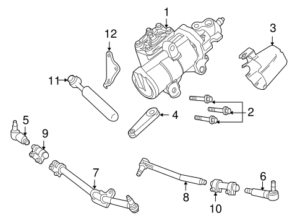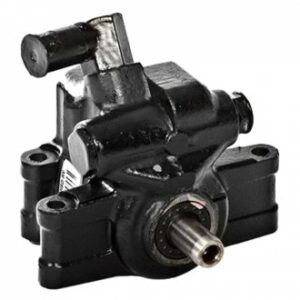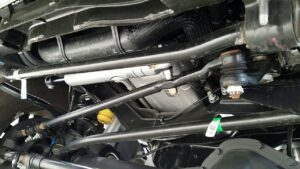Having knowledge of your car and all its parts is pretty important as it will help you take the right steps when you notice issues with the car. The Ford F250 steering does put you in control, however, some parts could turn your once smooth into a nightmare especially if you were not watching out for the signs before.
This article provides a detailed Ford F250 steering parts diagram and also gives you an idea of the problems that could spring up with your vehicle’s steering and what to do about them.
Ford F250 Steering Parts Diagram



Warning Signs of Steering Problems in Ford F250
Your vehicle wanders to one side
Your vehicle should not wander to the left or right on its own, however, this won’t be a problem in all situations. You could simply be driving on an uneven road with a significant slope. However, if this happens all of the time, and on even roads, you might have to check the steering. This could also be due to low tire pressure or uneven tire wire. A bad wheel alignment could also cause the vehicle to wander to one side as well as a faulty brake caliper. In a situation that the car wanders both ways at random, worn rods could be the culprit. It is best to send the car to the auto repair shop and have it inspected to find out the actual problem.
The steering wheel slips when you turn
If you turn your steering wheel and your tires do not follow, at some point, then you might have to brace up for a steering wheel problem. This is not common and you may not notice this right away until it gets worse. In most cases, you might have to repair or replace the steering rack to solve the problem.
Steering Wheel Feels sloppy
If your steering wheel feels loose such that you can move it back and forth without changing your direction of travel, then you have a problem with a steering system component. This is mostly due to worn or loose components in the steering stack. You should get a professional to inspect the vehicle and identify which component has issues
Vibration when Steering
If you’re driving on a smooth paved road and you notice a consistent vibration in the steering wheel or your car shudders, you might be dealing with a serious steering problem. The problem could be worn tie rods – the components that tie the steering gear or steering rack to the steering knuckles attached to your wheel hubs that produce the effect of a vibrating wheel. It could also make the car feel like it is shuddering. This situation could be caused by many other factors aside from a steering problem. It could be an unbalanced tire, uneven brake pad, and improper wheel alignment,
Power steering fluid foaming or bubbling
Power steering fluid is meant to be translucent with a reddish tint just like the automatic transmission fluid. However, if it looks dark and opaque or it is foamy, then there is a problem. If you’re noticing any steering problems or you take a look in the pump reservoir during maintenance and notice foaming or bubbles, it could mean there is a leak in the system and would have to be repaired. It could also mean that the fluid has to be replaced. However, if the fluid has a milky appearance, it could be a sign of moisture in the system which means you would have to flush the system.
Difficulty in Turning the Steering Wheel
If you’re driving a modern Ford F250, you might get to enjoy the power steering feature. This is a hydraulic pump or electric motor that assists you in turning the tires when the steering wheel is turned.
This function is not present in older vehicles which makes them much harder t steer. If you driving a modern Ford F250 and you’re having issues with turning the steering wheel, then there is probably something wrong with the power steering.
This could be a result of low power steering fluid in the reservoir which might indicate that there is a leak. You might also be having a faulty power steering pump or a broken (worn) serpentine belt. If your vehicle has an electric power assist, then a bad motor or blown fuse might be the culprit.
Car floats over road bumps
If you drive over road bumps and your car seems to float across them, then you might have to work on your shock absorbers or struts. They might be worn out and could later affect the steering.
When you drive, the suspension system is designed to counteract any weight transferred to maintain the traction of the vehicle. The shocks and struts are the main components that ensure that your vehicle maintains traction and will have to be replaced if you notice such problems.